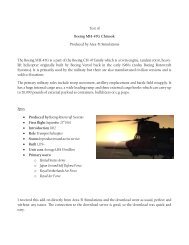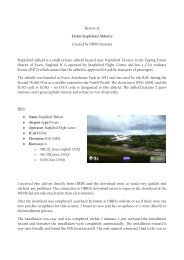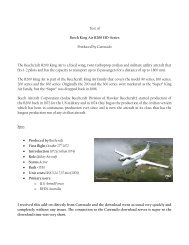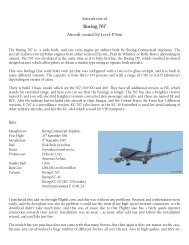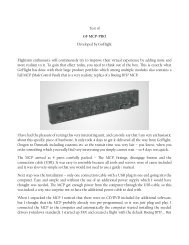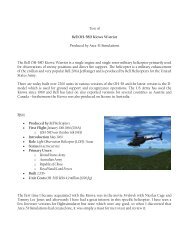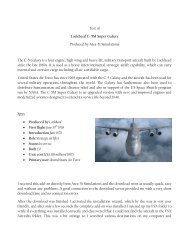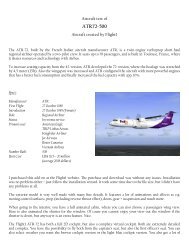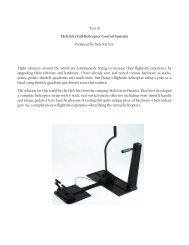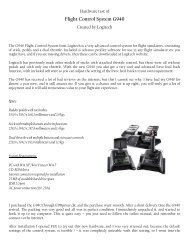Area-51 Simulations Lockheed U-2S Dragon Lady - Rays Aviation
Area-51 Simulations Lockheed U-2S Dragon Lady - Rays Aviation
Area-51 Simulations Lockheed U-2S Dragon Lady - Rays Aviation
Create successful ePaper yourself
Turn your PDF publications into a flip-book with our unique Google optimized e-Paper software.
Test of<br />
<strong>Lockheed</strong> U-<strong>2S</strong> <strong>Dragon</strong> <strong>Lady</strong><br />
Produced by <strong>Area</strong>-<strong>51</strong> <strong>Simulations</strong><br />
The U-2 spy plane is a single engine, very high altitude reconnaissance aircraft developed by <strong>Lockheed</strong><br />
and operated by the United States Air Force (USAF). Previously flown by the Central Intelligence<br />
Agency (CIA) and nicknamed the <strong>Dragon</strong> <strong>Lady</strong>.<br />
The original purpose of this aircraft was day and night reconnaissance from altitudes above 70,000 feet<br />
(21,000 m) but is today also used for electronic sensor research and development, satellite calibration<br />
and satellite data validation together with all-weather intelligence gathering.<br />
Specs:<br />
Produced by<br />
o <strong>Lockheed</strong> Skunk Works<br />
o <strong>Lockheed</strong> Martin<br />
First Flight August 1 st 1955<br />
Introduction 1957<br />
Role High Altitude Reconnaissance<br />
Status In active service<br />
Built 86<br />
Primary Users<br />
o United States Air Force<br />
o CIA<br />
o NASA<br />
o Republic of China Air Force<br />
I received this add-on directly from <strong>Area</strong>-<strong>51</strong> <strong>Simulations</strong> and the download went quick and easy and<br />
without any problems. The connection to the server that I downloaded from was really good so it did<br />
not take much time.
After downloading the file I started the installation process which was also very easy, quick and user<br />
friendly. Simply just activate the installation wizard and that is more or less all you have to do. In less<br />
than one minute I had installed the file and was ready for the real test phase.<br />
I opened up FSX to verify that the add-on had been installed correctly and of course it was. The<br />
<strong>Dragon</strong> <strong>Lady</strong> was nicely placed inside my virtual hangar and was represented by several different<br />
models of this very special bird as e.g. the TR-1B, ER-<strong>2S</strong>, U-<strong>2S</strong>, TU-<strong>2S</strong> and NASA and Air Force<br />
versions.<br />
To start the review I toured the outside of aircraft to get a view of all the details and of what level this<br />
add-on would represent. Externally the aircraft is extremely well made with a huge number of details,<br />
high quality textures (photoreal including bump maps) and lots and lots of animations and effect. The<br />
model is made with perfection and resembles the real counterpart 100% - it is very easy to see that<br />
<strong>Area</strong>-<strong>51</strong> indeed has spend a lot of time and focus on modeling this aircraft to perfection.<br />
You have various lightings as strobe, beacon, wingtip etc and they are all very nicely placed and fully<br />
working. Lots of animations as the gears including tires rolling and nose wheel turning, suspension,<br />
canopy, control surfaces etc – in all the model is very realistic and just to be completely sure, I found<br />
various pictures of the real version on the internet.
Going from the outside to the inside of the U-2 I found that <strong>Area</strong>-<strong>51</strong> <strong>Simulations</strong> had created both a 2D<br />
cockpit and a virtual cockpit (3D). The 2D cockpit is fair with photoreal textures, nice finish and<br />
various working switches and button animations. The 2D cockpit is very close to the real world<br />
cockpit of the U-2 and it is quite well made.<br />
The virtual cockpit is not that different in quality from the 2D cockpit. You have here a virtual cockpit<br />
that really provides the unique atmosphere and is built with the same precision as the model. There are<br />
good quality gauges, high quality textures, great finish and a superb depth. The cockpit has several<br />
animations as buttons, switches, gauges, controls etc and many of the buttons that you see are<br />
clickable. When I use this virtual cockpit on a high altitude missions, I always come to think of how it<br />
would be to actually fly this bird. It is very exciting and quite an experience as if I was employed at the<br />
real <strong>Area</strong>-<strong>51</strong> as a test pilot.<br />
I like the fact that <strong>Area</strong>-<strong>51</strong> has created the virtual cockpit so well, and that they also did include the<br />
controls to be the real “wheel” steering instead of a normal fighter stick. An eye for the detail is certain<br />
that <strong>Area</strong>-<strong>51</strong> has with this very beautiful bird, and I am very much surprised by the level of details that<br />
this aircraft is built with. Also the fact that <strong>Area</strong>-<strong>51</strong> <strong>Simulations</strong> have created several models and not<br />
just the U-<strong>2S</strong> is a huge plus, because I also really much like the trainer version (the twin seated TU-<br />
<strong>2S</strong>).
After viewing the virtual cockpit for quite some time, I turned my interest towards the sound set. The<br />
sound set included in the U-2 very good even though <strong>Area</strong>-<strong>51</strong> writes that it is just a custom sound set. I<br />
like it very much and I think that it fits the model and the atmosphere surrounding this aircraft<br />
perfectly. I tested the sound set in both stereo and in 7.1 surround sound, and found absolutely no<br />
problems. The sound is very realistic both heard from the cockpit but also when hearing from the<br />
outside of the aircraft.<br />
Overall this is an aircraft add-on of very good quality and it is actually not that difficult to fly. I believe<br />
that simmers on all level will be able to fly this bird, but I also do think that it is a good idea to use the<br />
autopilot when climbing above 60,000 ft due to the difference between the stalling speed versus the<br />
overspeed limitations are very close to each other. When flying at about 70,000 ft the aircraft is quite<br />
difficult to manually control and you feel the “ball” effect impacting your flight tremendously.<br />
I have viewed a lot of videos and real U-2 pilots comments regarding the U-2 spy plane, and here<br />
several pilots confirms that the aircraft is almost impossible to control when climbing over 65,000’, so<br />
if you want a flight to be as realistic as possible in these altitudes, then remember to use the autopilot.
To test this very interesting bird I flew several missions, both in daylight but also at nighttime, high<br />
altitude and low-to-medium altitude. My first test flight was actually not a mission but just a flight<br />
where I got a change of getting familiar with this aircraft. I took off from Nellis AFB a summer morning<br />
at 0400 and climbed to 15,000 ft. Here I tested the flight characteristic and power settings on the<br />
engine, and I found that the U-2 actually is very fast on the control surfaces. When I e.g. applied full<br />
ailerons to the left the U-2 tilted quickly leftover and it surprised me a lot to find the ailerons so<br />
effective. I view the size of the ailerons and compared it to the overall wing area, and my conclusion<br />
would be that it should not be that effective, but this I of course cannot confirm because I have never<br />
tried out the U-2 in real life (would very much like to)<br />
That said, I very quickly got used to how the U-2 reacts and it is a delight to fly this bird. You can<br />
almost turn it on a nickel and you don’t need to worry about engine power. The U-2 is an expert in<br />
steep climbs, so if you really wanted to stall this aircraft, you would have to throttle down to idle – at<br />
least when flying below 50,000 ft. Actually I also did test the stalling characteristics of the U-2 on this<br />
first test flight. You can rather easily get the U-2 to stall and hereafter go into a spin if you throttle<br />
down to idle and pitches up by +15 degrees while making a turn. The aircraft falls into the spin itself,<br />
but is also very easy to recover. If you don’t try to recover, then the U-2 will spin out of control, when<br />
trying this at high altitudes, but in lower altitudes the aircraft will recover more or less by itself.<br />
Landing the U-2 is simple. The airspeed can be kept very low due to a fantastic flap effect and a huge<br />
wing areal and this provides the pilot with more time to focus on touching down smoothly instead of<br />
just setting the wheels as quick as possible. You don’t need to worry about running out of runway, and<br />
if you set down far up the runway, then the U-2 is also equipped with very good brakes, so no problem.<br />
My second test flight was a long mission where I took off from Edwards AFB and climbing to 75,000’<br />
cruising to Karup AFB in Denmark. Here I got to experience the U-2 on a long and high altitude flight<br />
and this very well could have been a real mission. I was very excited and really lived myself into the
ole as a U-2 pilot, cruising twice the height of a commercial airliner and recording various information<br />
about potentially hostiles on the ground and on the water beneath me. The view from this altitude is<br />
spectacular – FSX gave me a very nice dark blue sky above and REX Overdrive gave me stunning<br />
clouds and waters beneath me – this was really a superb experience and after touchdown at Karup<br />
AFB I was ready to take the mission once again.<br />
I have later on flown this aircraft on several other different missions, and each time I fly the aircraft I<br />
get more and more in love with it. I haven’t seen that many U-2’s for flightsimulator, and I was very<br />
happy to see that <strong>Area</strong>-<strong>51</strong> had made one, and even more happy when I discovered which quality the<br />
aircraft was made with.<br />
This U-2 from <strong>Area</strong>-<strong>51</strong> I will of course recommend fellow flightsimmers to buy, and especially if you<br />
like (black) military aircrafts as the U-2, SR-71, B-2 etc, than this is a must have in your virtual hangar.<br />
You get a superb aircraft modeled to perfection with high quality textures, great finish and filled with<br />
details. Furthermore you also get a 2D and a virtual cockpit that is of a high standard and with good<br />
quality textures.<br />
I rate this add-on with 4.5/5 stars and thank the team at <strong>Area</strong>-<strong>51</strong> for this very beautiful bird, that I<br />
think have been missing for flightsimulator.<br />
<strong>Rays</strong> <strong>Aviation</strong>
U-2A<br />
Initial production, single-seat, J57-P-37A engine<br />
U-2B<br />
Twin-seat trainer, J57-P-31 engine<br />
Variants<br />
U-2C<br />
Enhanced single-seat model with J75-P-13 engine and modified engine intakes<br />
U-2D<br />
Enhanced twin-seat trainer<br />
U-2E<br />
Aerial refueling capable, J57-powered<br />
U-2F<br />
Aerial refueling capable, J75-powered<br />
U-2CT<br />
Enhanced twin-seat trainer rebuilt from U-2D airframes with relocation of the seats<br />
U-2G<br />
A-models modified with reinforced landing gear, added arresting hook, and wing spoilers for US Navy<br />
carrier operations<br />
U-2H<br />
Aircraft carrier capable, aerial refueling capable<br />
U-2R<br />
Re-designed enlarged airframes with underwing pods and increased fuel capacity<br />
U-2RT<br />
Enhanced twin-seat R-model trainer<br />
U-2EPX<br />
Proposed US Navy maritime surveillance R-model<br />
WU-2<br />
Atmospheric/weather research WU-model
TR-1A<br />
A third production batch of U-2R aircraft built for high-altitude tactical reconnaissance missions with<br />
side-looking radar, new avionics and improved ECM equipment. Re-designated U-<strong>2S</strong> after the fall of<br />
the Soviet Union<br />
TR-1B<br />
Two TR-1A airframes completed as twin-seat conversion trainers<br />
ER-2<br />
TR-1A 80-1063 modified as an Earth resources research aircraft, operated by the NASA High-Altitude<br />
Missions Branch, Ames Research Centre as NASA 706<br />
U-<strong>2S</strong><br />
New re-designation for the TR-1A; updated with a General Electric F118 engine, improved sensors, and<br />
addition of a GPS receiver<br />
TU-<strong>2S</strong><br />
New re-designated TR-1B two-seat trainer with improved engine
General characteristics<br />
Crew: One<br />
Length: 63 ft (19.2 m)<br />
Wingspan: 103 ft (31.4 m)<br />
Height: 16 ft (4.88 m)<br />
Wing area: 1,000 ft² (92.9 m²)<br />
Aspect ratio: 10.6<br />
Empty weight:: 14,300 lb (6,760 kg)<br />
Max. takeoff weight: 40,000 lb (18,100 kg)<br />
Power plant: 1 × General Electric F118-101 turbofan, 19,000 lbf (85 kN)<br />
Performance<br />
Maximum speed: 434 knots (500 mph, 805 km/h)<br />
Cruise speed: 373 knots (429 mph, 690 km/h)<br />
Range: 5,566 nmi (6,405 nmi, 10,300 km)<br />
Service ceiling: 70,000+ ft (21,300+ m)<br />
Flight endurance: 12 hours



